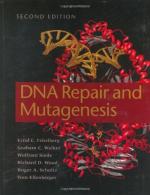|
This section contains 3,092 words (approx. 11 pages at 300 words per page) |

|
When it was discovered that DNA is the macromolecular carrier of essentially all genetic information, it was assumed that DNA is extremely stable. Consequently, it came as something of a surprise to learn that DNA is actually unstable and subject to continual damage. When DNA damage is severe, the cell is unable to replicate and may die. Repair of DNA must be regarded as essential for the preservation and transmission of genetic information in all life forms. In this article, we will discuss various types of DNA damage and the DNA repair systems that have evolved to correct that damage.
Sources of Damage
DNA is subject to spontaneous instability and decay. In addition to spontaneous damage, cellular DNA is under constant attack from reactive chemicals that the cell itself generates as by-products of metabolism. Moreover, the integrity of cellular DNA is assaulted by such environmental threats...
|
This section contains 3,092 words (approx. 11 pages at 300 words per page) |

|


